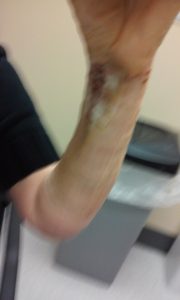May 2, 2016
People living with low vision trip a lot, stumble, and invariably too often fall, leaving them to seek solutions for the effects, which for me included trying turmeric for joint inflammation. For many, falling leads to broken bones [remember my shattered wrist last year], sprains–which I am constantly dealing with because of the activities I enjoy, and may trigger other conditions.  Options of what to do about this situation include sit rather than risk these events. No. Use the white cane I was trained to use during my sessions with the counselor from PA Office for Blindness and Visual Services [https://www.portal.state.pa.us/portal/server.pt/community/blindness_and_visual_services/10367/bbvs_office_directory/718649]. Not so much [more about this another time]. I do use marvelous hiking sticks when hiking, but as discovered last month, they don’t really alert me to tree roots in my path until I trip over them. Ahem…
Options of what to do about this situation include sit rather than risk these events. No. Use the white cane I was trained to use during my sessions with the counselor from PA Office for Blindness and Visual Services [https://www.portal.state.pa.us/portal/server.pt/community/blindness_and_visual_services/10367/bbvs_office_directory/718649]. Not so much [more about this another time]. I do use marvelous hiking sticks when hiking, but as discovered last month, they don’t really alert me to tree roots in my path until I trip over them. Ahem…
So, last month, I was on a hike through our woods with my husband and another dreaded fall happened. I am getting so much better at knowing how to do these things. Hence, my reference a couple of days ago to what I have been up to in spending my time learning to adapt. I tried to avoid falling but when it became clear it was inevitable, I fell backwards, landing on my butt, and not repeating any injury to my wrists. In the process, however, I did wrench my knee in a very awkward position because my foot was caught under a massive tree root hidden under the fall leaves that remained. And the knee promptly began to swell.
Because I have had a couple of prior hits to my knee[s] due to my failure to see something in my path [like a coffee table I sent flying], I have learned that I have a condition called calcium pyrophosphate deposition disease or CPPD [http://www.mayoclinic.org/diseases-conditions/pseudogout/basics/definition/con-20028152]. When I hit the coffee table with my knee, it triggered the condition, a reminder that so much of our health is an equation and when we communicate about it, we have to keep all the parts of the equation in mind.  Had I not hit the coffee table, I might never have known of this underlying condition [which would have been fine with me]. Since I did, I learned about it. I learned that 19-21 inches for a swelled knee [when the normal other knee is 15 inches] does not feel so good. I learned that a soft brace allowed me to go to work, though I put the leg up on a chair as often as possible. And I learned that after weeks of that, and still too much swelling and pain, a needle was used to aspirate the fluid…which hurt…but then the knee was closer to normal in size, though I was instructed to keep it wrapped in an ace bandage or the swelling would reappear. That lasted for awhile. And from it, I learned all about compression wear and ace bandages… So, fast forward, with this fall and swelling of the knee, I iced it and I wrapped it. And that kept the swelling to more like 17 inches as I watched it.
Had I not hit the coffee table, I might never have known of this underlying condition [which would have been fine with me]. Since I did, I learned about it. I learned that 19-21 inches for a swelled knee [when the normal other knee is 15 inches] does not feel so good. I learned that a soft brace allowed me to go to work, though I put the leg up on a chair as often as possible. And I learned that after weeks of that, and still too much swelling and pain, a needle was used to aspirate the fluid…which hurt…but then the knee was closer to normal in size, though I was instructed to keep it wrapped in an ace bandage or the swelling would reappear. That lasted for awhile. And from it, I learned all about compression wear and ace bandages… So, fast forward, with this fall and swelling of the knee, I iced it and I wrapped it. And that kept the swelling to more like 17 inches as I watched it.
Some weeks passed and I was catching up on some reading, including my subscription to “Mother Earth living”the Nov/Dec 2015 issue with the headline: ‘all about amazing turmeric.’ The article is quite lengthy; I recommend reading it. In the pages of positive summaries related to its effects, I went back recently to find if anything indicated anything negative. “Most of the laboratory-based evidence for curcumin does appear favorable, but we do have to be aware that there are limited reports of potential for adverse effects” [p. 70]. Curcumin is the commercial product designed to deliver turmeric in a time-released, more easily absorbed fashion. Under a section labeled “Safety” in the article, it is noted “Doses up to 8 grams a day of curcumin cause only mild side effects, primarily stomach upset, nausea and diarrhea” [p. 71].
 To be honest, I did not remember those cautionary phrases embedded in thousands of words. I just remembered the general gist when I began to have knee swelling that required bandaging…persistently. So I had looked up the research published regarding Curcumin. I liked what I saw. I bought the product. I took it. Day 2…I was sickkkkk. But I did not link it to Curcumin. I knew a friend had told me she takes turmeric when her arthritis acts up…keeps a bottle on the counter. I had literally felt relief in my knee 12 hours after taking a dose. I had told my sister. She then told me her husband uses the same product… It took until day 3 and being to the point of not keeping food down that I went back to the bottle and read it. Nothing about the stomach upset etc. Just a warning to pregnant or nursing women not to use it.
To be honest, I did not remember those cautionary phrases embedded in thousands of words. I just remembered the general gist when I began to have knee swelling that required bandaging…persistently. So I had looked up the research published regarding Curcumin. I liked what I saw. I bought the product. I took it. Day 2…I was sickkkkk. But I did not link it to Curcumin. I knew a friend had told me she takes turmeric when her arthritis acts up…keeps a bottle on the counter. I had literally felt relief in my knee 12 hours after taking a dose. I had told my sister. She then told me her husband uses the same product… It took until day 3 and being to the point of not keeping food down that I went back to the bottle and read it. Nothing about the stomach upset etc. Just a warning to pregnant or nursing women not to use it.
So I went to trusty WebMD [http://www.webmd.com/vitamins-supplements/ingredientmono-662-turmeric.aspx?activeingredientid=662]. I found the warning about stomach upset, which led me back to the Mother Earth article and the above. But, in addition to that content, WebMD noted under that side effects tab: ” Bleeding problems: Taking turmeric might slow blood clotting. This might increase the risk of bruising and bleeding in people with bleeding disorders. ”
That led me to read about interactions, where I found: “Medications that slow blood clotting (Anticoagulant / Antiplatelet drugs) interacts with TURMERIC. Turmeric might slow blood clotting. Taking turmeric along with medications that also slow clotting might increase the chances of bruising and bleeding. Some medications that slow blood clotting include aspirin, clopidogrel (Plavix), diclofenac (Voltaren, Cataflam, others), ibuprofen (Advil, Motrin, others), naproxen (Anaprox, Naprosyn, others), dalteparin (Fragmin), enoxaparin (Lovenox), heparin, warfarin (Coumadin), and others.”
UHHHHH, that is a pretty big oversight missing from the product label and discussion of Curcumin, wouldn’t you agree?








